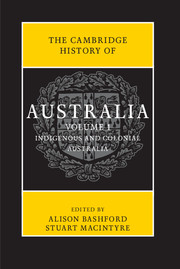Book contents
- Frontmatter
- Contents
- Abbreviations
- List of maps
- List of figures
- List of tables
- Notes on contributors
- Map
- Preface
- Introduction
- PART I
- PART II
- Further reading
- Chronology
- Index
- Frontmatter
- Contents
- Abbreviations
- List of maps
- List of figures
- List of tables
- Notes on contributors
- Map
- Preface
- Introduction
- PART I
- PART II
- 9 Religion
- 10 Culture and media
- 11 Science and medicine
- 12 Society and welfare
- 13 Gender and sexuality
- 14 Indigenous Australia
- 15 Class
- 16 The economy
- 17 Government, law and citizenship
- 18 Education
- 19 The environment
- 20 Travel and connections
- 21 Security
- 22 Australia, Britain and the British Commonwealth
- 23 Australia in the Asia-Pacfic region
- 24 The history anxiety
- Further reading
- Chronology
- Index
23 - Australia in the Asia-Pacfic region
from PART II
Published online by Cambridge University Press: 05 November 2013
- Frontmatter
- Contents
- Abbreviations
- List of maps
- List of figures
- List of tables
- Notes on contributors
- Map
- Preface
- Introduction
- PART I
- PART II
- Further reading
- Chronology
- Index
- Frontmatter
- Contents
- Abbreviations
- List of maps
- List of figures
- List of tables
- Notes on contributors
- Map
- Preface
- Introduction
- PART I
- PART II
- 9 Religion
- 10 Culture and media
- 11 Science and medicine
- 12 Society and welfare
- 13 Gender and sexuality
- 14 Indigenous Australia
- 15 Class
- 16 The economy
- 17 Government, law and citizenship
- 18 Education
- 19 The environment
- 20 Travel and connections
- 21 Security
- 22 Australia, Britain and the British Commonwealth
- 23 Australia in the Asia-Pacfic region
- 24 The history anxiety
- Further reading
- Chronology
- Index
Summary
In 1872 the colonies of Australia were connected to the British imperial cable network and by the time of Federation England was 100 minutes away from Australia, and 80 minutes from China. Although these technological developments made the world smaller, the new nation communicated with Asia and the Pacific region through the British network. This imperial arrangement was symbolic of a general pattern that continued well into the twentieth century.
Positioned within the British and then the US sphere, a full Australian engagement with the Asian region was slow. There were individuals who sought to build a specifically Australian relationship with the countries of Asia, especially in periods of heightened regional consciousness. The mid-1930s – with the world economic crisis and the continued rise of Japan – was one such period. The years immediately following World War 2 constituted another. A third occurred in the late 1980s, when the scale of Northeast Asia's economic potential became apparent. For most of the twentieth century, however, Australians who were concerned about the wider world concentrated on their imperial relationships. Richard Casey, a future Minister of External Affairs, observed in 1928 that information about Asia was ‘vague, muddled and defective’. Even when faced with the Japanese threat in the 1930s, there was little community interest in Asian affairs, and a lack of interest in foreign relations generally.
Although Australian universities created specialist expertise on the Asian region in the second half of the twentieth century, this seldom reached mainstream Australia. Cultural awareness was also limited. Those Australian artists who decided to draw inspiration from Asia tended to do so via Europe: ‘they travelled half-way round the world to learn from Europeans about art that had originated in their own hemisphere’. When Australians did reflect on their country's Asian context, they inclined to anxiety: a settler nation with a small population seemed at risk. Such is the dominant narrative of Australia's regional relations in the twentieth century.
Australian foreign policy, it is true, developed a regional as well as an imperial dimension.
- Type
- Chapter
- Information
- The Cambridge History of Australia , pp. 537 - 560Publisher: Cambridge University PressPrint publication year: 2013
- 1
- Cited by



